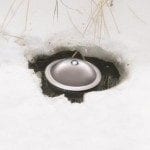Your cart is currently empty!
Get Event Reminders…
…twice a month by subscribing to our newsletter
Subscribe using the form in the page footer below.
Your cart is currently empty!
…twice a month by subscribing to our newsletter
Subscribe using the form in the page footer below.
Distractions happen, and things fall to the wayside. This year we were in the process of getting a new 2-acre pond ready for prime time, and we didn’t get things in our koi pond ready to go for the cold months nearly as early as we normally try to. So, it’s nearly December and you haven’t gotten everything ready to ensure an easy Spring. There’s still plenty that you can do now to make sure that you haven’t done too much damage to your pond ecosystem.
Assuming that you haven’t put up your net yet, you should definitely grab your skimming net and get to work. Clean out everything that you can without risking hypothermia. All of that organic debris will decompose slowly when it’s cold, but once things warm up it will go fast, adding tannins to your water (which leads to the dreaded tea-colored water), throwing off all of your pond’s water health balances, and adding to your sludge layer.
Even in winter, partial water changes can help to provide healthier, less polluted water for your be-finned friends. Do this very carefully, though, changing water much less aggressively than you would in warmer times. Slower winter metabolisms potentially means that your pond recovers from water changes less quickly. Don’t change out more than 5% of your water a week, preferably less, and be sure that the temperature of the water your adding is equalized to that in the pond before you add it.
Slower winter metabolisms don’t just affect larger animals and plants. Even bacteria slow way down, and that means that the beneficial bacteria in your pond aren’t cleaning it the way they do in warm months. Supplementing your system with special cold water adapted bacteria will go a long way toward making your Spring a happier experience.
Cold Water Fish Food
Unless you’re unusually scrupulous about cleaning up the rest of your yard, chances are that there are still leaves and other organic debris waiting to fall or in a position to be blown into your pond. The right pond net can save you considerable problems.
 A pond surface that’s completely covered with ice closes off gas exchange between the pond and the surrounding air, which can cause buildup of all kinds of things in the pond and lead to oxygen deficiency. Keep the water at least partially open using an aerator (my preferred method) or a heat source. if your pond does ice over, DO NOT break up the ice by hitting it with anything. Because water resists compression and therefore transmits kinetic energy very efficiently, the shock from the hit, even a relatively mild one, can hurt or even kill your fish, even if they’re nowhere near where you hit the ice. Just don’t do it. Use mild heat or a drill to get through the ice.
A pond surface that’s completely covered with ice closes off gas exchange between the pond and the surrounding air, which can cause buildup of all kinds of things in the pond and lead to oxygen deficiency. Keep the water at least partially open using an aerator (my preferred method) or a heat source. if your pond does ice over, DO NOT break up the ice by hitting it with anything. Because water resists compression and therefore transmits kinetic energy very efficiently, the shock from the hit, even a relatively mild one, can hurt or even kill your fish, even if they’re nowhere near where you hit the ice. Just don’t do it. Use mild heat or a drill to get through the ice.
Header image by Martin Schmidt.
Logging in to comment gives you more features, but it is not required.
The Christmas Fern got its name because it flowers in winter and stays green throughout the holidays. We discuss care for Chirstmas Fern
Feed them 1 pound of 10-10-10 per 100 sq ft. of garden s Reward yourself with luscious blackberries – plant a Blackberry bush! Perfect for limited space, 1 bush can produce 20 white flowers and a large crop of juicy, sweet-tasting blackberries in zones 5-8 with bright sun and well-drained soil. Care & feeding instructions included.
How to start seeds, germinate, grow and care for them is a gardener life skill. Many plants and vegetables fare better when started indoors.
Discover more information on Peace Lily houseplant, its care and array of cultivars, and its air-cleansing properties!
Learn how keystone plants play a crucial role in supporting wildlife and preserving biodiversity in Ontario gardens.
Witness first-hand the stunning art of topiary, once a lost art that is still found at Disney World, crafted from boxwood, yew, cypress and more. Learn more about topiary from BoxTrees.
The impressive Asiatic Lily is relatively easy to grow. Here are tips to be successful in producing and maintaining gorgeous blooms.
The terminology of ‘Extra Virgin’ was coined by the Romans to stop the practice of throwing hot water onto the olives before, and during crushing.
Landscape berms and mounds are an easy and attractive way to add interest to your yard and landscape. Building them isn’t complicated.
Graptopetalum is a genus of eighteen species under the family Crassulaceae. All species have the common names Ghost Plants and Leather Petal.
Composting has numerous environmental benefits from waste reduction to soil enrichment! Learn how composting contributes to a sustainable future for our planet.
Look at combinations of plants, colours, textures to match or complement. Use combinations of primary colours; complementary colours; analogous colours
GardeningCalendar.ca gets some funding from advertisers. If you click on links and advertisements at no cost to you, the site may receive a small commission that helps fund its operation.
© 2025 J&S Calendars Ltd.